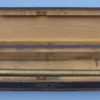TRAVELING READING TELESCOPE FOR LABORATORY RESEARCH
Stock Number: 10362
$950.
For sale, an early 19th century reading telescope for obtaining accurate readout of galvanometer deflections. The assembly attaches to a stand (not present) with a long sliding and clampable rod and the telescope provides good erect images with focusing between infinity and three feet. It is contained in its original fitted case.
Dimensions
the assembly 22-1/2 inches (57 cm) long
Circa
c. early 19th century
Country of manufacture
UK and Ireland
Description
TRAVELING READING TELESCOPE FOR LABORATORY RESEARCH, probably English, c. early 19th century. This lacquered brass instrument has a threaded assembly (for attachment to stand, not present) with spirit level, the assembly carrying a 22-1/2″ (57 cm) long sliding and clampable cylindrical rod labeled every inch (and divided every tenth inch) from 0″ to 17″. A vernier is divided to hundredths of an inch. A threaded fitting on one end of the rod carries a small telescope with achromatic objective and right angle eyepiece with internal mirror. This gives good erect images and focuses by drawtube over a broad range from infinity to as close as three feet. The apparatus is in excellent condition, contained in the original, now somewhat worn, fitted pine case, with finely shaped brass escutcheon.
The reading telescope, with its calibrated horizontal travel and close-focusing possibilities, was especially designed for accurate readout of galvanometer deflections, especially for the mirror type as developed by Poggendorff in 1826, and patented by William Thompson in 1858. Here we have a fine and particularly early example of the telescope system.
Ask the Dealer
Dealer information
 TESSERACT
TESSERACT
David and Yola Coffeen both have enjoyed academic careers, as planetary astronomer and as linguist/educator. But since 1982 (yes, 1982!) they have been full-time dealers in early scientific and medical instruments, under the name Tesseract. Selling primarily by catalogue (over 100 issued so far) they also have a web presence at www.etesseract.com, and can be contacted at [email protected].








